剑9阅读解析
剑桥雅思9阅读解析test2

剑桥雅思9阅读解析test2Passage1Question 1答案: H关键词: national policy定位原文: H段第1句“The New Zealand Government…”解题思路: 这一段的首句就以一种叙事口吻向考生交代了新西兰全国上下正在开展的一场为残疾人服务的战略,该句含义为“新西兰政府已经制定出一项‘新西兰残疾人事业发展战略’,并开始进入广泛咨询意见的阶段。
”另外,在该段其它语句中也提到the strategy recognises..., Objective 3...is to provide...等信息,非常符合题干中account一词的含义。
Question 2答案: C关键词: global team定位原文: C段最后一句“The International Institute of…”解题思路:这句含义为“在世界卫生组织的建议下,国际噪声控制工程学会(I-INCE)成立了一个国际工作小组来”,这句话中international能够对应题干中的global, 而working party能够对应team。
这是对应关系非常明显的一道题目。
Question 3答案: B关键词: hypothesis, reason, growth in classroom noise定位原文: B段第3句“Nelson and Soil have also suggested...”解题思路:在该段首句中就出现了classroom noise这个词,因此该段有可能就是本题的对应段落。
在接下来的叙述Nelson and Soil have also suggested...中,suggest一词能够对应题干中的hypothesis 后一句中的This all amounts to heightened activity and noise levels,与题干中的one reason相对应Question 4答案: I关键词: worldwide regulations对应原文: I 段最后一句“It is imperative that the needs…”解题思路:全文只有此句中提及国际标准,含义为“今后在制定和颁布国际标准时,必须把这些孩子的需求考虑进去。
剑桥雅思9真题及解析阅读Test3

剑桥雅思阅读真题答案:Question1—8:Y、N、Y、NG、Y、Y、N、YQuestion9—12:H、F、A、CPassage1整体分析体裁说明文题材语言学主题介绍两个语言学派的观点和态度段落概括第一段背景介绍:语言的普及性导致人们容易对其持有不同的看法第二段语言在社会各方面的影响第三段语言学派“规范主义”的观点第四段规范主义依赖于严格的语法规则及其目的第五段另一个语言学派“描写主义”的观点和态度第六段两个学派的现状及他们对彼此的误解雅思阅读重点词汇第一段objective adj.客观的debate n.争论,辩论linguistic adj.语言的,语言学的deteriorate v.衰退;恶化,变坏第二段criticise v.批评,批判social status社会地位exempt adj.被免除的,被豁免的identity n.身份;同一性第三段prescriptivism n.规范主义literature n.文学deviation n.背离be imposed on被强加于……之上adherent n.追随者第四段principle n.原则chaos n.混乱reliance n.依赖avoid v.避免beneath prep.在……之下dispute n.争论accurately adv.准确地,精确地alternative n.供代替的选择第五段motivate v.激发variation n.变化,改变第六段opposition n.反对valid adj.有效的advocate n.提倡者,支持者logic n.逻辑analysis n.分析diversity n.多样性halt v.停止,阻止original adj.最初的;独创的legislation n.立法;法律extreme adj.极端的考题精解Questions 1-8题型:判断题YES/NO/NOT GIVEN解析:判断题一般都是有顺序的,确定了第一道题的原文定位后,可以向后查找其他题目的答案。
解析剑桥Cambridge 9文章
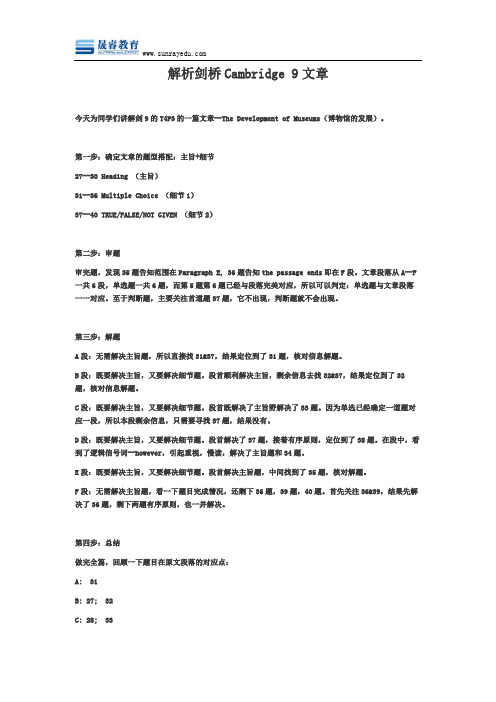
解析剑桥Cambridge 9文章今天为同学们讲解剑9的T4P3的一篇文章--The Development of Museums(博物馆的发展)。
第一步:确定文章的题型搭配:主旨+细节27--30 Heading (主旨)31--36 Multiple Choice (细节1)37--40 TRUE/FALSE/NOT GIVEN (细节2)第二步:审题审完题,发现35题告知范围在Paragraph E, 36题告知the passage ends即在F段。
文章段落从A--F 一共6段,单选题一共6题,而第5题第6题已经与段落完美对应,所以可以判定:单选题与文章段落一一对应。
至于判断题,主要关注首道题37题,它不出现,判断题就不会出现。
第三步:解题A段:无需解决主旨题,所以直接找31&37,结果定位到了31题,核对信息解题。
B段:既要解决主旨,又要解决细节题。
段首顺利解决主旨,剩余信息去找32&37,结果定位到了32题,核对信息解题。
C段:既要解决主旨,又要解决细节题。
段首既解决了主旨野解决了33题。
因为单选已经确定一道题对应一段,所以本段剩余信息,只需要寻找37题,结果没有。
D段:既要解决主旨,又要解决细节题。
段首解决了37题,接着有序原则,定位到了38题。
在段中,看到了逻辑信号词--however,引起重视,慢读,解决了主旨题和34题。
E段:既要解决主旨,又要解决细节题。
段首解决主旨题,中间找到了35题,核对解题。
F段:无需解决主旨题,看一下题目完成情况,还剩下36题,39题,40题。
首先关注36&39,结果先解决了36题,剩下两题有序原则,也一并解决。
第四步:总结做完全篇,回顾一下题目在原文段落的对应点:A: 31B: 27; 32C: 28; 33D: 37; 38; 29; 34E: 30; 35F: 36; 39; 40我们会发现以下规律:1,本篇的两种细节题(单选;判断)遵循内部有序原则。
剑桥雅思9阅读解析test3

Passage 1Question 1答案: YES关键词: reasons, arguments occur定位原文: 第1段第2、3句“Popular linguistic debate... 〞语言学上的普通争论通常会晋级为谩骂和论战。
语言属于所有人,所以大多数人认为他们有权保存自己对语言的看法。
解题思路: 题干要判断对于语言的争论,原因是否可以理解。
原文陈述,语言属于所有人,大多数人有权保存对语言的看法,所以人们的观点会产生分歧是可以理解的。
题干与原文完全一致。
Question 2答案: NO关键词: language education, language usage定位原文:第1段第4句“And when opinions differ,…〞而当看法出现分歧时,人们可能变得情绪冲动。
语言用法方面的一点小事,就能像语言学教育政策中的重大问题一样很容易引起争论。
解题思路:题干要判断人们对待语言教育的态度是否比对待语言用法的态度更加强烈。
原文陈述,语言用法方面的一点小事都能像语言学教育政策中的大事一样引起争论,这说明对待语言用法与语言学教育政策的态度同样强烈。
题干与原文所述观点不一致。
Question 3答案: YES关键词: intelligence, affect定位原文:第2段第2句“No part of society or social…〞所有社会组成局部或者社会行为无一例外。
语言因素影响我们如何判断一个人的个性、智力、社会地位、教育程度、工作才能以及许多身份与社会生存的其他方面。
解题思路:题干要判断使用语言的方式是否会影响人们对一个人智力的评估。
原文陈述,语言因素影响我们如何判断一个人的个性、智力……题干与原文完全一致。
Question 4答案: NOT GIVEN关键词: prescriptive, 18th century对应原文:第4段第1句“All the main languages…〞解题思路:对所有主要语言的研究都是约定俗成的,尤其在18世纪对语法与词典的编写过程中。
雅思剑9发布,深度剖析阅读题型及要点
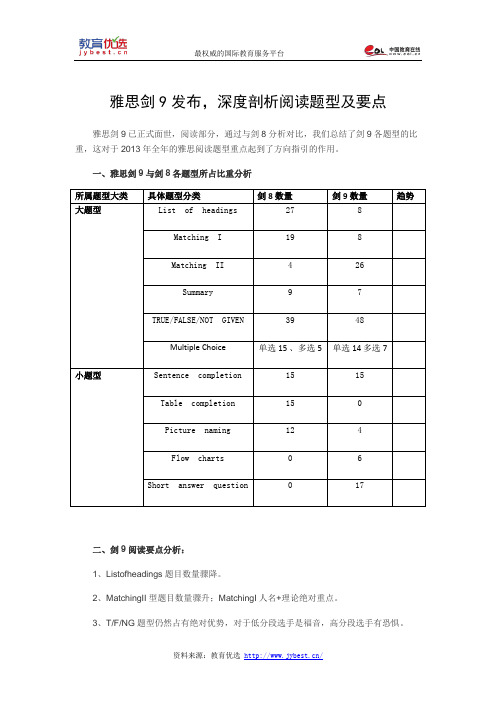
雅思剑9发布,深度剖析阅读题型及要点
雅思剑9已正式面世,阅读部分,通过与剑8分析对比,我们总结了剑9各题型的比重,这对于2013年全年的雅思阅读题型重点起到了方向指引的作用。
一、雅思剑9与剑8各题型所占比重分析
所属题型大类具体题型分类剑8数量剑9数量趋势大题型List of headings278
Matching I198
Matching II426
Summary97
TRUE/FALSE/NOT GIVEN3948
Multiple Choice单选15 、多选5单选14 多选7
小题型Sentence completion1515
Table completion150
Picture naming124
Flow charts06
Short answer question017
二、剑9阅读要点分析:
1、Listofheadings题目数量骤降。
2、MatchingII型题目数量骤升;MatchingI人名+理论绝对重点。
3、T/F/NG题型仍然占有绝对优势,对于低分段选手是福音,高分段选手有恐惧。
4、Multiplechoice单选,多选并无出众表现。
5、SUMMARY从数量上看微少。
6、小题型总体数量有所上升,特别是Shortanswerquestion简答题。
剑桥雅思9真题解析-Test4阅读Passage2

剑桥雅思9真题解析-Test4阅读Passage2智课网IELTS备考资料剑桥雅思9真题+解析-Test4阅读Passage2摘要:雅思阅读成绩不易提高,在辛苦备考的同时,大家要准备好有价值的备考雅思资料,小编为您带来剑桥雅思9真题+解析-Test4阅读Passage2的内容介绍,好好看看吧。
剑桥雅思阅读真题答案:Question 14—19:G、C、F、D、H、EQuestion 20—23:D、B、E、CQuestion 24—26:mirror、communication、ownershipPassage2整体分析体裁议论文题材学术研究主题幼儿的身份意识段落概括A段背景介绍:简要介绍幼儿的自我意识的特征及与之相关理论的由来B段小孩自我认识的第一步C段通过他人模仿和镜中反射的自我认识D段幼儿作为主体的实证研究不足E段自我意识发展的第二步——自我作为客体F段自我与他人、自我与社会关系的研究G段刘易斯和布鲁克斯—冈恩的研究发现H段生动的自我意识表达通过愤怒来表现考题精解Questions 14-19题型:配对题MATCHING解析:本题型为段落信息配对题,命题的两大特点为:彻底同义替换和绝对乱序。
所以,应从理解段落入手,而不是按照题目顺序来寻找答案。
同时,留意题目要求中是否有NB信息,这意味着是否有段落会被复选。
14.雅思阅读关键词account,method,researchers, a particular study原文定位G段第三句开始到本段结尾In one experiment, Lewis and Brooks-Gunn … unless other cues such as movement are present.题解原文涉题句描述了一个experiment,研究人员通过在小孩的鼻子上涂抹红色的粉末来观察小孩的反映。
原文中对整个实验的细节描述对应了题干中的account(记述),涂抹粉末这个方法就对应了题干中的method,experiment 对应题干的study,人名Lewis and Brooks-Gunn 对应题干中的researchers。
剑桥雅思阅读9(test1)原文答案解析
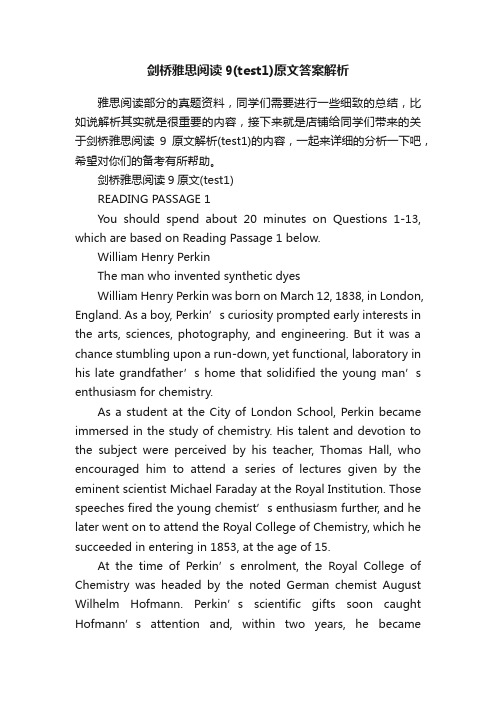
剑桥雅思阅读9(test1)原文答案解析雅思阅读部分的真题资料,同学们需要进行一些细致的总结,比如说解析其实就是很重要的内容,接下来就是店铺给同学们带来的关于剑桥雅思阅读9原文解析(test1)的内容,一起来详细的分析一下吧,希望对你们的备考有所帮助。
剑桥雅思阅读9原文(test1)READING PASSAGE 1You should spend about 20 minutes on Questions 1-13, which are based on Reading Passage 1 below.William Henry PerkinThe man who invented synthetic dyesWilliam Henry Perkin was born on March 12, 1838, in London, England. As a boy, Perkin’s curiosity prompted early intere sts in the arts, sciences, photography, and engineering. But it was a chance stumbling upon a run-down, yet functional, laboratory in his late grandfather’s home that solidified the young man’s enthusiasm for chemistry.As a student at the City of London School, Perkin became immersed in the study of chemistry. His talent and devotion to the subject were perceived by his teacher, Thomas Hall, who encouraged him to attend a series of lectures given by the eminent scientist Michael Faraday at the Royal Institution. Those speeches fired the young chemist’s enthusiasm further, and he later went on to attend the Royal College of Chemistry, which he succeeded in entering in 1853, at the age of 15.At the time of Perkin’s enrolment, the Royal College of Chemistry was headed by the noted German chemist August Wilhelm Hofmann. Perkin’s scientific gifts soon caught Hofmann’s attention and, within two years, he becameHofmann’s youngest assistant. Not long after that, Perkin made the scientific breakthrough that would bring him both fame and fortune.At the time, quinine was the only viable medical treatment for malaria. The drug is derived from the bark of the cinchona tree, native to South America, and by 1856 demand for the drug was surpassing the available supply. Thus, when Hofmann made some passing comments about the desirability of a synthetic substitute for quinine, it was unsurprising that his star pupil was moved to take up the challenge.During his vacation in 1856, Perkin spent his time in the laboratory on th e top floor of his family’s house. He was attempting to manufacture quinine from aniline, an inexpensive and readily available coal tar waste product. Despite his best efforts, however, he did not end up with quinine. Instead, he produced a mysterious dark sludge. Luckily, Perkin’s scientific training and nature prompted him to investigate the substance further. Incorporating potassium dichromate and alcohol into the aniline at various stages of the experimental process, he finally produced a deep purple solution. And, proving the truth of the famous scientist Louis Pasteur’s words ‘chance favours only the prepared mind’, Perkin saw the potential of his unexpected find.Historically, textile dyes were made from such natural sources as plants and animal excretions. Some of these, such as the glandular mucus of snails, were difficult to obtain and outrageously expensive. Indeed, the purple colour extracted from a snail was once so costly in society at the time only the rich could afford it. Further, natural dyes tended to be muddy in hue and fade quickly. It was against this backdrop that Perkin’sdiscovery was made.Perkin quickly grasped that his purple solution could be used to colour fabric, thus making it the world’s first synthetic dye. Realising the importance of this breakthrough, he lost no time in patenting it. But perhaps the most fascinating of all Perkin’s reactions to his find was his nearly instant recognition that the new dye had commercial possibilities.Perkin originally named his dye Tyrian Purple, but it later became commonly known as mauve (from the French for the plant used to make the colour violet). He asked advice of Scottish dye works owner Robert Pullar, who assured him that manufacturing the dye would be well worth it if the colour remained fast (i.e. would not fade) and the cost was relatively low. So, over the fierce objections of his mentor Hofmann, he left college to give birth to the modern chemical industry.With the help of his father and brother, Perkin set up a factory not far from London. Utilising the cheap and plentiful coal tar that was an almost unlimited byproduct of London’s gas street lighting, the dye works began producing the world’s first synthetically dyed material in 1857. The company received a commercial boost from the Empress Eugenie of France, when she decided the new colour flattered her. Very soon, mauve was the necessary shade for all the fashionable ladies in that country. Not to be outdone, England’s Queen Victoria also appeared in public wearing a mauve gown, thus making it all the rage in England as well. The dye was bold and fast, and the public clamoured for more. Perkin went back to the drawing board.Although Perkin’s fame was achieved and fortune assured by his first discovery, the chemist continued his research. Among other dyes he developed and introduced were aniline red (1859)and aniline black (1863) and, in the late 1860s, Perkin’s green. It is important to note that Perkin’s synthetic dye discoveries had outcomes far beyond the merely decorative. The dyes also became vital to medical research in many ways. For instance, they were used to stain previously invisible microbes and bacteria, allowing researchers to identify such bacilli as tuberculosis, cholera, and anthrax. Artificial dyes continue to play a crucial role today. And, in what would have been particularly pleasing to Perkin, their current use is in the search for a vaccine against malaria.Questions 1-7Do the following statements agree with the information given in Reading Passage 1?In boxes 1-7 on your answer sheet, writeTRUE if the statement agrees with the informationFALSE if the statement contradicts the informationNOT GIVEN if there is no information on this1 Michael Faraday was the first person to recognise Perkin’s ability as a student of chemistry.2 Michael Faraday suggested Perkin should enrol in the Royal College of Chemistry.3 Perkin employed August Wilhelm Hofmann as his assistant.4 Perkin was still young when he made the discovery that made him rich and famous.5 The trees from which quinine is derived grow only in South America.6 Perkin hoped to manufacture a drug from a coal tar waste product.7 Perkin was inspired by the discoveries of the famous scientist Louis Pasteur.Questions 8-13Answer the questions below.Choose NO MORE THAN TWO WORDS from the passage for each answer.Write your answers in boxes 8-13 on your answer sheet.8 Before Perkin’s discovery, with what group in society was the colour purple associated?9 What potential did Perkin immediately understand that his new dye had?10 What was the name finally used to refer to the first colour Perkin invented?11 What was the name of the person Perkin consulted before setting up his own dye works?12 In what country did Perkin’s newly invented colour first become fashionable?13 According to the passage, which disease is now being targeted by researchers using synthetic dyes?READING PASSAGE 2You should spend about 20 minutes on Questions 14-26, which are based on Reading Passage 2 on the following pages.Questions 14-17Reading Passage 2 has five paragraphs, A-E.Choose the correct heading for paragraphs B-E from the list of headings below.Write the correct number, i-vii, in boxes 14-17 on your answer sheet.List of Headingsi Seeking the transmission of radio signals from planetsii Appropriate responses to signals from other civilisations iii Vast distances to Earth’s closest neighboursiv Assumptions underlying the search for extra-terrestrial intelligencev Reasons for the search for extra-terrestrial intelligencevi Knowledge of extra-terrestrial life formsvii Likelihood of life on other planetsExample AnswerParagraph A v14 Paragraph B15 Paragraph C16 Paragraph D17 Paragraph EIS THERE ANYBODY OUT THERE?The Search for Extra-terrestrial IntelligenceThe question of whether we are alone in the Universe has haunted humanity for centuries, but we may now stand poised on the brink of the answer to that question, as we search for radio signals from other intelligent civilisations. This search, often known by the acronym SETI (search for extra-terrestrial intelligence), is a difficult one. Although groups around the world have been searching intermittently for three decades, it is only now that we have reached the level of technology where we can make a determined attempt to search all nearby stars for any sign of life.AThe primary reason for the search is basic curiosity hethe same curiosity about the natural world that drives all pure science. We want to know whether we are alone in the Universe. We want to know whether life evolves naturally if given the right conditions, or whether there is something very special about the Earth to have fostered the variety of life forms that, we seearound us on the planet. The simple detection of a radio signal will be sufficient to answer this most basic of all questions. In this sense, SETI is another cog in the machinery of pure science which is continually pushing out the horizon of our knowledge. However, there are other reasons for being interested in whether life exists elsewhere. For example, we have had civilisation on Earth for perhaps only a few thousand years, and the threats of nuclear war and pollution over the last few decades have told us that our survival may be tenuous. Will we last another two thousand years or will we wipe ourselves out? Since the lifetime of a planet like ours is several billion years, we can expect that, if other civilisations do survive in our galaxy, their ages will range from zero to several billion years. Thus any other civilisation that we hear from is likely to be far older, on average, than ourselves. The mere existence of such a civilisation will tell us that long-term survival is possible, and gives us some cause for optimism. It is even possible that the older civilisation may pass on the benefits of their experience in dealing with threats to survival such as nuclear war and global pollution, and other threats that we haven’t yet discovered.BIn discussing whether we are alone, most SETI scientists adopt two ground rules. First, UFOs (Unidentified Flying Objects) are generally ignored since most scientists don’t consider the evidence for them to be strong enough to bear serious consideration (although it is also important to keep an open mind in case any really convincing evidence emerges in the future). Second, we make a very conservative assumption that we are looking for a life form that is pretty well like us, since if it differs radically from us we may well not recognise it as a life form,quite apart from whether we are able to communicate with it. In other words, the life form we are looking for may well have two green heads and seven fingers, but it will nevertheless resemble us in that it should communicate with its fellows, be interested in the Universe, live on a planet orbiting a star like our Sun, and perhaps most restrictively, have a chemistry, like us, based on carbon and water.CEven when we make these assumptions, our understanding of other life forms is still severely limited. We do not even know, for example, how many stars have planets, and we certainly do not know how likely it is that life will arise naturally, given the right conditions. However, when we look at the 100 billion stars in our galaxy (the Milky Way), and 100 billion galaxies in the observable Universe, it seems inconceivable that at least one of these planets does not have a life form on it; in fact, the best educated guess we can make, using the little that we do know about the conditions for carbon-based life, leads us to estimate that perhaps one in 100,000 stars might have a life-bearing planet orbiting it. That means that our nearest neighbours are perhaps 100 light years away, which is almost next door in astronomical terms.DAn alien civilistation could choose many different ways of sending information across the galaxy, but many of these either require too much energy, or else are severely attenuated while traversing the vast distances across the galaxy. It turns out that, for a given amount of transmitted power, radio waves in the frequency range 1000 to 3000 MHz travel the greatest distance, and so all searches to date have concentrated on looking forradio waves in this frequency range. So far there have been a number of searches by various groups around the world, including Australian searches using the radio telescope at Parkes, New South Wales. Until now there have not been any detections from the few hundred stars which have been searched. The scale of the searches has been increased dramatically since 1992, when the US Congress voted NASA $10 million per year for ten years to conduct, a thorough search for extra-terrestrial life. Much of the money in this project is being spent on developing the special hardware needed to search many frequencies at once. The project has two parts. One part is a targeted search using the world’s largest radio telescopes, the American-operated telescope in Arecibo, Puerto Rico and the French telescope in Nancy in France. This part of the project is searching the nearest 1000 likely stars with high sensitivity for signals in the frequency rang 1000 to 3000 MHz. The other part of the project is an undirected search which is monitoring all of space with a lower sensitivity, using the smaller antennas of NASA’s Deep Space Network.EThere is considerable debate over how we should react if we detect a signal from an alien civilisation. Everybody agrees that we should not reply immediately. Quite apart from the impracticality of sending a reply over such large distances at short notice, it raises a host of ethical questions that would have to be addressed by the global community before any reply could be sent. Would the human race face the culture shock if faced with a superior and much older civilisation? Luckily, there is no urgency about this. The stars being searched are hundreds of light years away, so it takes hundreds of years for their signal toreach us, and a further few hundred years for our reply to reach them. It’s not important, then, if there’s a delay of a few years, or decades, while the human race debates the question of whether to reply, and perhaps carefully drafts a reply.Questions 18-20Answer the questions below.Choose NO MORE THAN THREE WORDS AND/OR A NUMBER from the passage for each answer.Write your answers in boxes 18-20 on your answer sheet.18 What is the life expectancy of Earth?19 What kind of signals from other intelligent civilisations are SETI scientists searching for?20 How many stars are the world’s most powerful radio telescopes searching?Questions 21-26Do the following statements agree with the views of the writer in Reading Passage 2?In boxes 21-26 on your answer sheet, writeYES if the statement agrees with the views of the writerNO if the statement contradicts the views of the writerNOT GIVEN if it is impossible to say what the writer thinks about this21 Alien civilisations may be able to help the human race to overcome serious problems.22 SETI scientists are trying to find a life form that resembles humans in many ways.23 The Americans and Australians have co-operated on joint research projects.24 So far SETI scientists have picked up radio signals from several stars.25 The NASA project attracted criticism from some members of Congress.26 If a signal from outer space is received, it will be important to respond promptly.READING PASSAGE 3You should spend about 20 minutes on Questions 27-40, which are based on Reading Passage 3 below.The history of the tortoiseIf you go back far enough, everything lived in the sea. At various points in evolutionary history, enterprising individuals within many different animal groups moved out onto the land, sometimes even to the most parched deserts, taking their own private seawater with them in blood and cellular fluids. In addition to the reptiles, birds, mammals and insects which we see all around us, other groups that have succeeded out of water include scorpions, snails, crustaceans such as woodlice and land crabs, millipedes and centipedes, spiders and various worms. And we mustn’t forget the pla nts, without whose prior invasion of the land none of the other migrations could have happened.Moving from water to land involved a major redesign of every aspect of life, including breathing and reproduction. Nevertheless, a good number of thorough going land animals later turned around, abandoned their hard-earned terrestrial re-tooling, and returned to the water again. Seals have only gone part way back. They show us what the intermediates might have been like, on the way to extreme cases such as whales and dugongs. Whales (including the small whales we call dolphins) and dugongs, with their close cousins the manatees, ceased to be land creatures altogether and reverted to the full marine habits of their remote ancestors. They don’t even come ashoreto breed. They do, however, still breathe air, having never developed anything equivalent to the gills of their earlier marine incarnation. Turtles went back to the sea a very long time ago and, like all vertebrate returnees to the water, they breathe air. However, they are, in one respect, less fully given back to the water than whales or dugongs, for turtles still lay their eggs on beaches.There is evidence that all modern turtles are descended from a terrestrial ancestor which lived before most of the dinosaurs. There are two key fossils called Proganochelys quenstedti and Plaeochersis talampayensis dating from early dinosaur times, which appear to be close to the ancestry of all modern turtles and tortoises. You might wonder how we can tell whether fossil animals lived on land or in water, especially if only fragments are found. Sometimes it’s obvious. Ichthyosaurs were reptilian contemporaries of the dinosaurs, with fins and streamlined bodies. The fossils look like dolphins and they surely lived like dolphins, in the water. With turtles it is a little less obvious. One way to tell is by measuring the bones of their forelimbs.Walter Joyce and Jacques Gauthier, at Yale University, obtained three measurements in these particular bones of 71 species of living turtles and tortoises. They used a kind of triangular graph paper to plot the three measurements against one another. All the land tortoise species formed a tight cluster of points in the upper part of the triangle; all the water turtles cluster in the lower part of the triangular graph. There was no overlap, except when they added some species that spend time both in water and on land. Sure enough, these amphibious species show up on the triangular graph approximately half way between the ‘wet cluster’ of sea turtles and the ‘dry cluster’of land tortoises. The next step was to determine where the fossils fell. The bones of P. quenstedti and P. talampayensis leave us in no doubt. Their points on the graph are right in the thick of the dry cluster. Both these fossils were dry-land tortoises. They come from the era before our turtles returned to the water.You might think, therefore, that modern land tortoises have probably stayed on land ever since those early terrestrial times, as most mammals did after a few of them went back to the sea. But apparently not. If you draw out the family three of all modern turtles and tortoises, nearly all the branches are aquatic. Today’s land tortoises constitute a single branch, deeply nested among branches consisting of aquatic turtles. This suggests that modern land tortoises have not stayed on land continuously since the time of P. quenstedti and P. talampayensis. Rather, their ancestors were among those who went back to the water, and they then reemerged back onto the land in (relatively) more recent times.Tortoises therefore represent a remarkable double return. In common with all mammals, reptiles and birds, their remote ancestors were marine fish and before that various more or less worm-like creatures stretching back, still in the sea, to the primeval bacteria. Later ancestors lived on land and stayed there for a very large number of generations. Later ancestors still evolved back into the water and became sea turtles. And finally they returned yet again to the land as tortoises, some of which now live in the driest of deserts.Questions 27-30Answer the questions below.Choose NO MORE THAN TWO WORDS from the passage for each answer.Write your answers in boxes 27-30 on your answer sheet.27 What had to transfer from sea to land before any animals could migrate?28 Which TWO processes are mentioned as those in which animals had to make big changes as they moved onto lands?29 Which physical feature, possessed by their ancestors, do whales lack?30 which animals might ichthyosaurs have resembled?Questions 31-33Do the following statements agree with the information given in Reading Passage 3?In boxes 31-33 on your answer sheet, writeTRUE if the statement agrees with the informationFALSE if the statement contradicts the informationNOT GIVEN if there is no information on this31 Turtles were among the first group of animals to migrate back to the sea.32 It is always difficult to determine where an animal lived when its fossilised remains are incomplete.33 The habitat of ichthyosaurs can be determined by the appearance of their fossilised remains.Questions 34-39Complete the flow-chart below.Choose NO MORE THAN TWO WORDS AND/OR A NUMBER from the passage for each answer.Write your answers in boxes 34-39 on your answer sheet.Method of determining where the ancestors of turtles and tortoises come fromStep 171 species of living turtles and tortoises were examined anda total of 34 ……………………. were taken from the bones of theirforelimbs.Step 2The data was recorded on a 35 ……………….. (necessary for comparing the information).Outcome: Land tortoises were represented by a dense 36 …………………………… of points towards the top.Sea turtles were grouped together in the bottom part.Step 3The same data was collected from some living 37 ………………. species and added to the other results.Outcome: The points for these species turned out to be positioned about 38 ……………… up the triangle between the land tortoises and the sea turtles.Step 4Bones of P. quenstedti and P. talampayensis were examined in a similar way and the results added.Outcome: The position of the points indicated that both these ancient creatures were 39…………..Question 40Choose the correct letter, A, B, C or D.Write the correct letter in box 40 on your answer sheet.According to the writer, the most significant thing about tortoises is thatA they are able to adapt to life in extremely dry environments.B their original life form was a kind of primeval bacteria.C they have so much in common with sea turtles.D they have made the transition from sea to land more than once.剑桥雅思阅读9原文参考译文(test1)PASSAGE 1参考译文:William Henry Perkin 合成染料的发明者Wiliam Henry Perkin于1838年3月12日出生于英国伦敦。
剑9 Test3 Reading passage 3解析
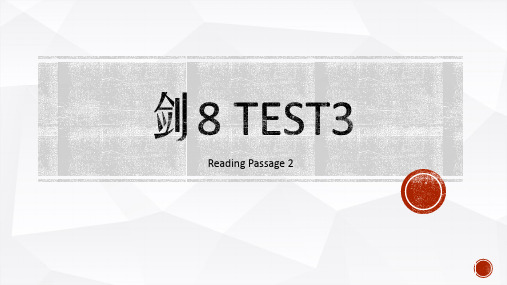
sea has been developed in the North Sea oil industry and much is already known about turbine blade design, because of wind power and ship propellers.(C段第4 句)
be designed to be lifted out of the water for maintenance and to clean seaweed from the blades.(D段最后一句)
定位词:raise,extraction
答案:maintenance
题目解析 题干中fish and other creatures就是sea life, unlikely to be at risk替换了not in danger。
定位词:another industry,applying technoligy 答案:C
题目解析 题干中的wind power在A段出现得比较多,仔细阅读便能发现跟题干相似的意思——
wind在此句中以原形出现,而reliable被替换为predictable和constant。
(A段第一句)
从解析来看很多答案出现在某段的段首或段尾不妨我们以后可以在理解文章大意的基础上再去这些地方寻找到答案能节省不少时间
Reading Passage 2
全文概括:潮汐能(Tidal Power)对于英国的作用及重要性,还有关于潮汐能的介绍。 题型:Question 14-17是段落信息匹配题
Question 18-22是多选题
定位词:location,first 答案:C
题目解析 题干中说的是一种把生产在某处的能源带回英国的方式,很明显能对应到E段。
剑九阅读答案精讲欣赏
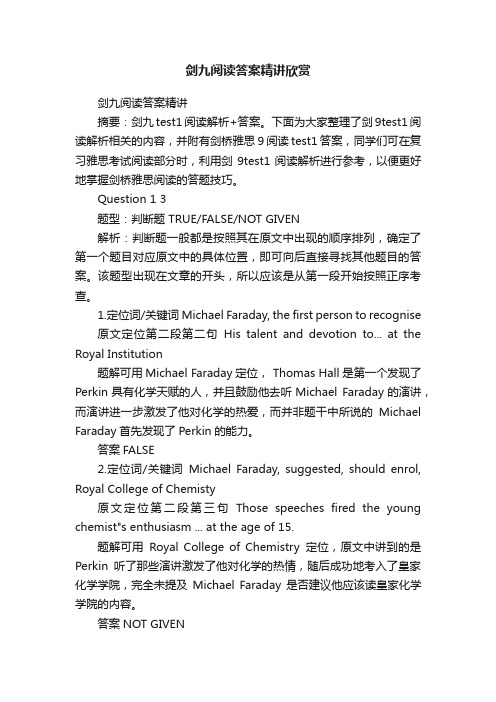
剑九阅读答案精讲欣赏剑九阅读答案精讲摘要:剑九test1阅读解析+答案。
下面为大家整理了剑9test1阅读解析相关的内容,并附有剑桥雅思9阅读test1答案,同学们可在复习雅思考试阅读部分时,利用剑9test1阅读解析进行参考,以便更好地掌握剑桥雅思阅读的答题技巧。
Question 1 3题型:判断题 TRUE/FALSE/NOT GIVEN解析:判断题一般都是按照其在原文中出现的顺序排列,确定了第一个题目对应原文中的具体位置,即可向后直接寻找其他题目的答案。
该题型出现在文章的开头,所以应该是从第一段开始按照正序考查。
1.定位词/关键词Michael Faraday, the first person to recognise原文定位第二段第二句His talent and devotion to... at the Royal Institution题解可用Michael Faraday定位, Thomas Hall是第一个发现了Perkin具有化学天赋的人,并且鼓励他去听Michael Faraday的演讲,而演讲进一步激发了他对化学的热爱,而并非题干中所说的Michael Faraday首先发现了Perkin的能力。
答案FALSE2.定位词/关键词Michael Faraday, suggested, should enrol, Royal College of Chemisty原文定位第二段第三句Those speeches fired the young chemist"s enthusiasm ... at the age of 15.题解可用Royal College of Chemistry定位,原文中讲到的是Perkin听了那些演讲激发了他对化学的热情,随后成功地考入了皇家化学学院,完全未提及Michael Faraday是否建议他应该读皇家化学学院的内容。
答案NOT GIVEN3.定位词/关键词emloyed, August Wilhelm Hofmann, as his assistant原文定位第三段第二句Perkin"s scientific gifts soon caught Hofmann"s attention and, within two years, he because Hofmann"s youngest assistant.题解可用特殊名词assistant定位,原文讲的是Perkin的天赋很快引起了Hofmann的注意,并且在不到两年的时间里,Perkin成了Hofmann最年轻的助手。
雅思剑桥9阅读解析

雅思剑桥9阅读解析
剑桥雅思9是备考雅思阅读部分的重要参考资料。
本书的阅读材料涵盖了多个话题,如科学、历史、文化等,考察了考生的阅读理解能力和解题技巧。
下面将对剑桥雅思9中的阅读部分进行详细解析。
本书的阅读部分由三篇阅读文章组成,每篇文章后都有对应的习题。
文章内容涵盖了不同的难度和题型,能够帮助考生全面掌握阅读技巧。
第一篇文章主要讲述了关于环保的话题。
文章通过介绍澳大利亚面对的环境问题以及政府采取的措施,引导考生理解和掌握环保方面的重要信息,并进行相关问题的解答。
第二篇文章主要谈论了动物迁徙的现象。
文章中给出了一些动物迁徙的具体实例,如鸟类、鲨鱼等,考察考生对动物迁徙原因和方式的理解。
考生需要从文章中获取相关信息,并回答相应的问题。
第三篇文章是一篇历史方面的文章,介绍了欧洲中世纪的风车。
文章探讨了风车在农业和工业发展中的重要作用,从而帮助考生理解欧洲中世纪社会的一些特点和变迁。
在解析这些文章时,我的建议是,首先通读全文,把握整体内容;然后细读每一段,理解段落的主题和关键信息;最后回答习题时,注意审题,并参考文章中的具体信息进行答题。
剑桥雅思9的阅读部分是一份很好的备考资料,通过对其中的文章进行仔细解析和练习,考生可以提高自己的阅读能力和解题技巧,为取得良好的雅思阅读成绩奠定基础。
剑桥雅思9阅读Passage1解析
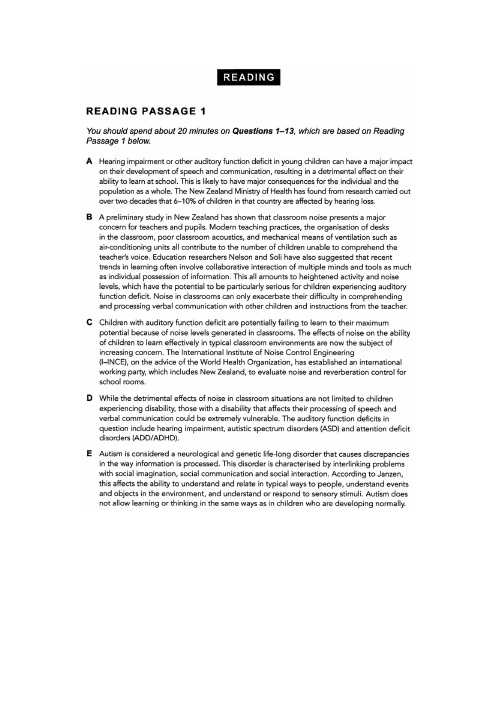
剑桥雅思阅读真题答案:Question 1—6:H、C、B、I、D、AQuestion 7—10:two decades、crowd(noise)、invisible(disabilities/disability)、invisible(disabilities/disability)Question 11—12:A、CPassage1整体分析体裁说明文题材科技应用主题青少年的听力障碍及应对措施段落概括 A 段引出话题,并概要性介绍新西兰卫生部对本国青少年听力障碍的相关研究数据。
B 段教室噪音是老师和学生最关注的问题。
C 段相关国际机构也开场关注噪音在传统教学中对孩子的影响。
D 段听力障碍的几种常见病症E 段自闭症的典型特征及其对孩子学习上的影响F 段注意力不集中症的典型特征及其对孩子学习上的影响G 段隐形听力障碍儿童在学习环境中的受关注度愈加不够。
H 段新西兰政府应对儿童听力障碍的新举措。
I 段其他国家的类似效仿措施考题精解Questions 1-6题型:段落信息配对题MATCHING解析:该题型是雅思阅读中的五星级难题,即乱序,出题思路点也很繁杂;所以尽管它通常为文章之后的第一个题型,但是在解答阅读套题时,建议考生最后再解决它。
4.6.Questions 7-10题型:简答题SHORT ANSWER QUESTIONS解析:该题型是雅思阅读中的传统题型,属于顺序题型,多考察原文细节,难度系数中等。
8.10.Questions 11 and 12题型:多项选择题MULTIPLE CHOICE解析:该题型是雅思阅读中选择题中的非常考题型,通常可以归为顺序题型方向,多考察原文细节,难度系数中等。
Question 13题型:单项选择题MULTIPLE CHOICE解析:该题型是雅思阅读中选择题中的常考题型,属于典型的顺序题型,多考察原文细节,难度系数中等。
剑9阅读难句解析1. While the detrimental effects of noise in classroom situations are not limited to children experiencing disability, those with a disability that affects their processing of speech and verbal communication could be extremely vulnerable.解析:while引导让步状语从句,表示“尽管,即使〞;句中的are not limited to意为“不局限于〞;experiencing disability是动名词短语作后置定语,修饰children; with a disability是介词短语作后置定语,修饰代词those;that引导定语从句,修饰先行词disability。
剑桥雅思9真题 解析-Test3阅读Passage1Attitudes to language

剑桥雅思9真题解析-Test3阅读Passage1Attitudes to language第一段:It is not easy to be systematic and objective about language study.系统客观的英语学习并不容易Popular linguistic debate regularly deteriorates into invective and polemic.流行语言的争论经常恶化成谩骂和争辩Language belongs to everyone, so most people feel they have a right to hold an opinion about it.语言属于每一个人,所以大多数人都觉得他们有权对它发表意见。
And when opinions differ, emotions can run high. Arguments can start as easily over minor points of usage as over major policies of linguistic education.??当意见不同的时候,情绪会高涨。
争论可以很容易地从一个小的使用点,如在语言教育的主要政策。
?生词:?systematic系统的、linguistic语言的、debate争论、deteriorates恶化、invective谩骂、polemic 争论、第二段:Language, moreover, is a very public behaviour, so it is easy for different usages to be noted and criticised.语言,更是一个非常公共的行为,所以它更容易为不同的用途被注意和批评。
No part of society or social behaviour is exempt: linguistic factors influence how we judge personality, intelligence, social status, educational standards, job aptitude, and many other areas of identity and social survival.社会或社会行为是不受影响的:语言因素的影响我们如何判断个性、智力、社会地位、教育水平、工作能力和许多其他领域的身份和社会生存。
剑桥雅思阅读9原文答案解析(test4)
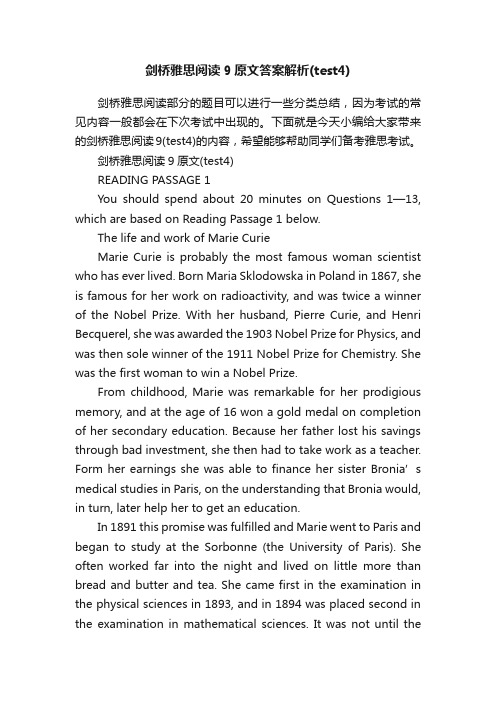
剑桥雅思阅读9原文答案解析(test4)剑桥雅思阅读部分的题目可以进行一些分类总结,因为考试的常见内容一般都会在下次考试中出现的。
下面就是今天小编给大家带来的剑桥雅思阅读9(test4)的内容,希望能够帮助同学们备考雅思考试。
剑桥雅思阅读9原文(test4)READING PASSAGE 1You should spend about 20 minutes on Questions 1—13, which are based on Reading Passage 1 below.The life and work of Marie CurieMarie Curie is probably the most famous woman scientist who has ever lived. Born Maria Sklodowska in Poland in 1867, she is famous for her work on radioactivity, and was twice a winner of the Nobel Prize. With her husband, Pierre Curie, and Henri Becquerel, she was awarded the 1903 Nobel Prize for Physics, and was then sole winner of the 1911 Nobel Prize for Chemistry. She was the first woman to win a Nobel Prize.From childhood, Marie was remarkable for her prodigious memory, and at the age of 16 won a gold medal on completion of her secondary education. Because her father lost his savings through bad investment, she then had to take work as a teacher. Form her e arnings she was able to finance her sister Bronia’s medical studies in Paris, on the understanding that Bronia would, in turn, later help her to get an education.In 1891 this promise was fulfilled and Marie went to Paris and began to study at the Sorbonne (the University of Paris). She often worked far into the night and lived on little more than bread and butter and tea. She came first in the examination in the physical sciences in 1893, and in 1894 was placed second in the examination in mathematical sciences. It was not until thespring of that year that she was introduced to Pierre Curie.Their marriage in 1895 marked the start of a partnership that was soon to achieve results of world significance. Following Henri Becquerel’s discovery in 1896 of a new phenomenon, which Marie later called ‘‘radioactivity’, Marie Curie decided to find out if the radioactivity discovered in uranium was to be found in other elements. She discovered that this was true for thorium.Turning her attention to minerals, she found her interest drawn to pitchblende, a mineral whose radioactivity, superior to that of pure uranium, could be explained only by the presence in the ore of small quantities of an unknown substance of very high activity. Pierre Curie joined her in the work that she had undertaken to resolve this problem, and that led to the discovery of the new elements, polonium and radium. While Pierre Curie devoted himself chiefly to the physical study of the new radiations, Marie Curie struggled to obtain pure radium in the metallic state. This was achieved with the help of the chemist Andre-Louis Debierne, one of Pierre Curie’s pupils. Based on the results of this research, Marie Curie received her Doctorate of Science, and in 1903 Marie and Pierre shared with Becquerel the Nobel Prize for Physics for the discovery of radioactivity.The births of Marie’s two daughters, lrène and Eve, in 1897 and 1904 failed to interrupt her scientific work. She was appointed lecturer in physics at the Ecole Normale Supérieure for girls in Sèvres, France (1900), and introduced a method of teaching based on experimental demonstrations. In December 1904 she was appointed chief assistant in the laboratory directed by Pierre Curie.The sudden death of her husband in 1906 was a bitter blow to Marie Curie, but was also a turning point in her career:henceforth she was to devote all her energy to completing alone the scientific work that they had undertaken. On May 13, 1906, she was appointed to the professorship that had been left vacant on her hu sband’s death, becoming the first woman to teach at the Sorbonne. In 1911 she was awarded the Noble Prize for Chemistry for the isolation of a pure form of radium.During World War I, Marie Curie, with the help of her daughter Irène, devoted herself to the development of the use of X-radiography, including the mobile units which came to be known as ‘Little Curies’, used for the treatment of wounded soldiers. In 1918 the Radium Institute, whose staff Irène had joined, began to operate in earnest, and became a centre for nuclear physics and chemistry. Marie Curie, now at the highest point of her fame and, from 1922, a member of the Academy of Medicine, researched the chemistry of radioactive substances and their medical applications.In 1921, accompanied by her two daughters, Marie Curie made a triumphant journey to the United States to raise funds for research on radium. Women there presented her with a gram of radium for her campaign. Marie also gave lectures in Belgium, Brazil, Spain and Czechoslovakia and, in addition, had the satisfaction of seeing the development of the Curie Foundation in Paris, and the inauguration in 1932 in Warsaw of the Radium Institute, where her sister Bronia became director.One of Marie Curie’s outstanding achievements was to have understood the need to accumulate intense radioactive sources, not only to treat illness but also to maintain an abundant supply for research. The existence in Paris at the Radium Institute of a stock of 1.5 grams of radium made a decisive contribution to the success of the experiments undertaken in the years around1930. This work prepared the way for the discovery of the neutron by Sir James Chadwick and, above all, for the discovery in 1934 by lrène and Frédéric Joliot Curie of artificial radioactivity.A few months after this discovery, Marie Curie died as a result of leukaemia caused by exposure to radiation. She had often carried test tubes containing radioactive isotopes in her pocket, remarking on the pretty blue-green light they gave off.Her contribution to physics had been immense, not only in her own work, the importance of which had been demonstrated by her two Nobel Prizes, but because of her influence on subsequent generations of nuclear physicists and chemists.Questions 1—6Do the following statements agree with the information given in Reading Passage 1? In boxes 1—6 on your answer sheet, writeTRUE if the statement agrees with the informationFALSE if the statement contradicts the informationNOT GIVEN if there is no information on this1 Marie Curie’s husband was a joint winner of both Marie’s Nobel Prizes.2 Marie became interested in science when she was a child.3 Marie was able to attend the Sorbonne because of her sister’s financial contribution.4 Marie stopped doing research for several years when her children were born.5 Marie took over the teaching position her husband had held.6 Marie’s sister Bronia studied the medical uses of radioactivity.Questions 7—13Complete the notes below.Choose ONE WORD from the passage for each answer.Write your answers in boxes 7—13 on your answer sheet.Marie Curie’s research on radioactivityWhen uranium was discovered to be radioactive, Marie Curie found that the element called 7______ had the same property.Marie and Pierre Curi e’s research into the radioactivity of the mineral known as 8_______ led to the discovery of two elements.In 1911, Marie Curie received recognition for her work on the element 9_______Marie and lrène Curie developed X-radiography which was used as a medical technique for 10 ______Marie Curie saw the importance of collecting radioactive material both for research and for cases of 11 ______.The radioactive material stocked in Paris contributed to the discoveries in the 1930s of the 12 ______ and of what was know as artificial radioactivity.During her research, Marie Curie was exposed to radiation and as a result she suffered from 13 ______.READING PASSAGE 2You should spend about 20 minutes on Questions 14—26 which are based on Reading Passage 2 below.Y oung children’s sense of identityA. A sense of self develops in young children by degrees. The process can usefully be thought of in terms of the gradual emergence of two somewhat separate features: the self as a subject, and the self as an object. William James introduced the distinction in 1892, and contemporaries of his, such as Charles Cooley, added to the developing debate. Ever since thenpsychologists have continued building on the theory.B. According to James, a child’s first step on the road to self-understanding can be seen as the recognition that he or she exists. This is an aspect of the self that he labeled ‘self-as-subject’, and he gave it various elements. These included an awareness of one’s own agency (i.e. one’s power to act), and an awa reness of one’s distinctiveness from other people. These features gradually emerge as infants explore their world and interact with caregivers. Cooley (1902) suggested that a sense of the self-as-subject was primarily concerned with being able to exercise power. He proposed that the earliest examples of this are an infant’s attempts to control physical objects, such as toys or his or her own limbs. This is followed by attempts to affect the behaviour of other people. For example, infants learn that when they cry or smile someone responds to them.C. Another powerful source of information for infants about the effects they can have on the world around them is provided when others mimic them. Many parents spend a lot of time, particularly in the early months, copying their infant’s vocalizations and expressions. In addition, young children enjoy looking in mirrors, where the movements they can see are dependent upon their own movements. This is not to say that infants recognize the reflection as their own image (a later development). However, Lewis and Brooks-Gunn (1979) suggest that infants’ developing understanding that the movements they see in the mirror are contingent on their own, leads to a growing awareness that they are distinct from other people. This is because they, and only they, can change the reflection in the mirror.D. This understanding that children gain of themselves asactive agent continues to develop in their attempts to co-operate with others in play. Dunn (1988) points out that it is in such day-to –day relationships and interactions that the child’s understanding of his-or herself emerges. Empirical investigations of the self-as-subject in young children are, however, rather scarce because of difficulties of communication: even if young infants can reflect on their experience, they certainly cannot express this aspect of the self directly.E. Once children have acquired a certain level of self-awareness, they begin to place themselves in whole series of categories, which together play such an important part in defining them uniquely as ‘themselves’. This second step in the development of a full sense of self is what James called the ‘self-as-object’. This has been seen by many to be the aspect of the self which is most influenced by social elements, since it is made up of social roles (such as student, brother, colleague) and characteristics which derive their meaning from comparison or interaction with other people (such as trustworthiness, shyness, sporting ability).F. Cooley and other researchers suggested a close connection between a person’s own understanding of their identity and other people’s understanding of it. Cooley believed that people build up their sense of identity form the reactions of others to them, and form the view they believe others have of them. He called the self-as-object the ‘looking-glass self’, since people come to see themselves as they are reflected in others. Mead (1934) went even further and saw the self and the social world as inextricably bound together: ‘Th e self is essentially a social structure, and it arises in social experience… it is impossible to conceive of a self arising outside of socialexperience.’G. Lewis and Brooks-Gunn argued that an important developmental milestone is reached when children become able to recognize themselves visually without the support of seeing contingent movement. This recognition occurs around their second birthday. In one experiment, Lewis and Brooks-Gunn (1979) dabbed some red powder on the noses of children who were playing in front of a mirror, and then observed how often they touched their noses. The psychologists reasoned that if the children knew what they usually looked like, they would be surprised by the unusual red mark and would start touching it. On the other hand, they found that children of 15 to 18 months are generally not able to recognize themselves unless other cues such as movement are present.H. Finally, perhaps the most graphic expressions of self-awareness in general can be seen in the displays of rage which are most common from 18 months to 3 years of age. In a longitudinal study of groups of three or four children, Bronson (1975) found that the intensity of the frustration and anger in their disagreements increased sharply between the ages of 1 and 2 years. Often, the children’s disagreements involved a struggle over a toy that none of them had played with before or after the tug-of-war: the children seemed to be disputing ownership rather than wanting to play with it. Although it may be less marked in other societies, the link between the sense of ‘self’ and of ‘ownership’ is a notable feature of childhood in Western societies.Questions 14—19Reading Passage 2 has eight paragraphs, A—H.Which paragraph contains the following information?Write the correct letter, A—H, in boxes 14-19 on your answer sheet.NB You may use any letter more than once.14 an account of the method used by researchers in a particular study15 the role of imitation in developing a sense of identity16 the age at which children can usually identify a static image of themselves17 a reason for the limitations of scientific research into ‘self-as-subject’18 reference to a possible link between culture and a particular form of behaviour19 examples of the wide range of features that contribute to the sense of ‘self-as-object’Questions 20—23Look at the following findings (Questions 20—23) and the list of researchers below.Match each finding with the correct researcher or researchers, A—E.Write the correct letter, A—E, in boxes 20—23 on your answer sheet.20 A sense of identity can never be formed without relationships with other people.21 A child’s awareness of self is related to a sense of mastery over things and people.22 At a certain age, children’s sense of identity leads t o aggressive behaviour.23 Observing their own reflection contributes to children’s self awareness.List of ResearchersA JamesB CooleyC Lewis and Brooks-GunnD MeadE BronsonQuestions 24—26Complete the summary below.Choose ONE WORD ONLY from the passage for each answer.Write your answers in boxes 24—26 on your answers sheet.How children acquire a sense of identityFirst, children come to realize that they can have an effect on the world around them,for example by handling objects, or causing the image to move when they face a 24 ______. This aspect of self-awareness is difficult to research directly, because of 25______ problems.Secondly, children start to become aware of how they are viewed by others. One important stage in this process is the visual recognition of themselves which usually occurs when they reach the age of two. In Western societies at least, the development of self awareness is often linked to a sense of 26 ______, and can lead to disputes.READING PASSAGE 3You should spend about 20 minutes on Questions 27-40, which are based on Reading Passage 3 on the following pages.Questions 27-30Reading Passage 3 has six paragraphs, A—F.Choose the correct heading for paragraphs B—E from the list of headings below.Write the correct number, i—vii, in boxes 27—30 on your answer sheet.List of Headingsi Commercial pressures on people in chargeii Mixed views on current changes to museumsiii Interpreting the facts to meet visitor expectationsiv The international dimensionv Collections of factual evidencevi Fewer differences between public attractionsvii Current reviews and suggestionsExample AnswerParagraph A v27 Paragraph B28 Paragraph C29 Paragraph D30 Paragraph EThe Development of MuseumsA. The conviction that historical relics provide infallible testimony about the past is rooted in the nineteenth and early twentieth centuries, when science was regarded as objective and value free. As one writer observes: ‘Although it is now evident that artefacts are as easily altered as chronicles, public faith in their veracity endures: a tangible relic seems ipso facto real’. Such conviction was, until recently, reflected in museum displays. Museums used to look — and some still do — much like storage rooms of objects packed together in showcases: good for scholars who wanted to study the subtle differences in design, but not for the ordinary visitor, to whom it all looked alike. Similarly, the information accompanying the objects often made little sense to the lay visitor. The content and format of explanations dated back to a time when the museum was the exclusive domain of the scientific researcher.B. Recently, however, attitudes towards history and the way it should be presented have altered. The key word in heritage display is now ‘experience’, the more exciting the better and, if possible, involving all the senses. Good examples of this approach in the UK are the Jorvik Centre in York; the National Museum of Photography, Film and Television in Bradford; and the Imperial War Museum in London. In the US the trend emerged much earlier: Williamsburg has been a prototype for many heritage developments in other parts of the world. No one can predict where the process will end. On so-called heritage sites the re-enactment of historical events is increasingly popular, and computers will soon provide virtual reality experiences, which will present visitors with a vivid image of the period of their choice, in which they themselves can act as if part of the historical environment. Such developments have been criticized as an intolerable vulgarization, but the success of many historical theme parks and similar locations suggests that the majority of the public does not share this opinion.C. In a related development, the sharp distinction between museum and heritage sites on the one hand, and theme parks on the other, is gradually evaporating. They already borrow ideas and concepts from one another. For example, museums have adopted story lines for exhibitions, sites have accepted ‘theming’ as a r elevant tool, and theme parks are moving towards more authenticity and research-based presentations. In zoos, animals are no longer kept in cages, but in great spaces, either in the open air or in enormous greenhouses, such as the jungle and desert environ ments in Burgers’ Zoo in Holland. This particular trend is regarded as one of the major developments in the presentation of natural history in the twentieth century.D. Theme parks are undergoing other changes, too, as they try to present more serious social and cultural issues, and move away from fantasy. This development is a response to market forces and, although museums and heritage sites have a special, rather distinct, role to fulfil, they are also operating in a very competitive environment, where visitors make choices on how and where to spend their free time. Heritage and museum experts do not have to invent stories and recreate historical environments to attract their visitors: their assets are already in place. However, exhibits must be both based on artefacts and facts as we know them, and attractively presented. Those who are professionally engaged in the art of interpreting history are thus in difficult position, as they must steer a narrow course between the demands of ‘evidence’ and ‘attractiveness’, especially given the increasing need in the heritage industry for income-generating activities.E. It could be claimed that in order to make everything in heritage more ‘real’, historical accuracy must be increasingly altered. For example, Pithecanthropus erectus is depicted in an Indonesian museum with Malay facial features, because this corresponds to public perceptions. Similarly, in the Museum of Natural History in Washington, Neanderthal man is shown making a dominant gesture to his wife. Such presentations tell us more about contemporary perceptions of the world than about our ancestors. There is one compensation, however, for the professionals who make these interpretations: if they did not provide the interpretation, visitors would do it for themselves, based on their own ideas, misconceptions and prejudices. And no matter how exciting the result, it would contain a lot more bias than the presentations provided by experts.F. Human bias is inevitable, but another source of bias in the representation of history has to do with the transitory nature of the materials themselves. The simple fact is that not everything from history survives the historical process. Castles, palaces and cathedrals have a longer lifespan than the dwellings of ordinary people. The same applies to the furnishing and other contents of the premises. In a town like Leyden in Holland, which in the seventeenth century was occupied by approximately the same number of inhabitants as today, people lived within the walled town, an area more than five times smaller than modern Leyden. In most of the houses several families lived together in circumstances beyond our imagination. Yet in museums, fine period rooms give only an image of the lifestyle of the upper class of that era. No wonder that people who stroll around exhibitions are filled with nostalgia; the evidence in museums indicates that life was so much better in past. This notion is induced by the bias in its representation in museums and heritage centres.Questions 31—36Choose the correct letter, A, B, C or D.Write the correct letter in boxes 31-36 on your answer sheet.31 Compared with today’s museums, those of the past.A did not present history in a detailed way.B were not primarily intended for the public.C were more clearly organised.D preserved items with greater care.32 According to the writer, current trends in the heritage industryA emphasise personal involvement.B have their origins in York and London.C rely on computer images.D reflect minority tastes.33 The writer says that museums, heritage sites and theme parksA often work in close partnership.B try to preserve separate identities.C have similar exhibits.D are less easy to distinguish than before.34 The writer says that in preparing exhibits for museums, expertsA should pursue a single objective.B have to do a certain amount of language translation.C should be free from commercial constraints.D have to balance conflicting priorities.35 In paragraph E, the writer suggests that some museum exhibitsA fail to match visitor expectations.B are based on the false assumptions of professionals.C reveal more about present beliefs than about the past.D allow visitors to make more use of their imagination.36 The passage ends by noting that our view of history is biased becauseA we fail to use our imagination.B only very durable objects remain from the past.C we tend to ignore things that displease us.D museum exhibits focus too much on the local area.Questions 37—40Do the following statements agree with the information given in Reading Passage 3?In boxes 37—40 on your answer sheet, writeTRUE if the statement agrees with the informationFALSE if the statement contradicts the informationNOT GIVEN if there is no information on this37 Consumers prefer theme parks which avoid serious issues.38 More people visit museums than theme parks.39 The boundaries of Leyden have changed little since the seventeenth century.40 Museums can give a false impression of how life used to be.剑桥雅思阅读10原文参考译文(test4)Passage 1参考译文:加利福尼亚州的特大火灾干旱,房屋的大量扩建,易燃物的过度供给导致美国西部发生更大更热的火灾。
雅思剑9阅读解析
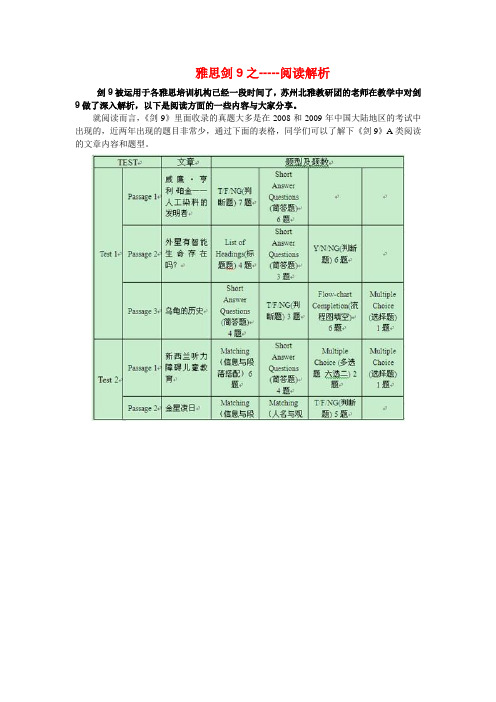
雅思剑9之-----阅读解析剑9被运用于各雅思培训机构已经一段时间了,苏州北雅教研团的老师在教学中对剑9做了深入解析,以下是阅读方面的一些内容与大家分享。
就阅读而言,《剑9》里面收录的真题大多是在2008和2009年中国大陆地区的考试中出现的,近两年出现的题目非常少,通过下面的表格,同学们可以了解下《剑9》A类阅读的文章内容和题型。
从上面的表格中,我们可以看出《剑9》中收录的阅读文章的背景还是以科普类的文章居多,这符合雅思考试的两个测试特点International(国际化)和None-professional(非专业化)。
此外,就题型类别上,我们通常说的雅思阅读5种重点题型:T/F/NG(判断题)、Matching (搭配题)、Multiple Choice (选择题)、Summary(摘要填空)和List of Headings(标题题)都有出现,而且T/F/NG(判断题)、Matching (搭配题)和Multiple Choice (选择题)3种题型的题量占了绝对优势,总和接近题目总量的70%。
另外我们常说的3种次要题型:Short Answer Questions (简答题)、Sentence Completion (完成句子)和Flow-chart, Diagram and Table Completion(图表题)在《剑9》中,Short Answer Questions (简答题)的题量上升至17题,Sentence Completion (完成句子)也达到了15题,紧跟在前3种绝对优势的重点题型之后,值得广大“烤鸭”们注意。
《剑9》里面收录的真题大多是在2008和2009年中国大陆地区的考试中出现的,而不是最近两年的考题。
结合2013年前两个月的考试,T/F/NG(判断题)和Matching (搭配题)依旧独领风骚,是雅思阅读的重点刀法,但在近两个月的考试中,几乎每次都出现了Summary(摘要填空)。
剑桥雅思9test4阅读PASSAGE1翻译:Marie Curie的生活与工作

剑9test4阅读PASSAGE1翻译:Marie Curie的生活与工作相应的解析,请点击:剑桥雅思9Test1阅读Passage1答案解析。
更多解析,请点击:剑桥雅思9解析。
剑桥雅思9Test1阅读Passage2答案解析Marie Curie大概是史上最著名的女科学家。
她于1867年出生在波兰,原名Marie Sklodowska,因其在放射化学方面的成就而著名,并两度问鼎诺贝尔奖;1903年,她同丈夫Pierre Curie以及Henri Becquerel被授予诺贝尔物理学奖,1911年她又独立获得诺贝尔化学奖。
她是世界上第一位获得诺贝尔奖的女性。
自幼年起,Marie就以惊人的记忆力而出名。
她在16岁完成中等教育时获得了金牌。
但由于父亲投资失败,家中积蓄所剩无几,Marie不得不靠教书维持生活。
有了这笔收入,她就能先资助姐姐Bronia在巴黎学医,而Bronia也承诺,作为回报以后会帮助她继续完成学业。
1891年,Bronia兑现了她的承诺。
Marie来到巴黎,开始在巴黎大学学习。
她经常学至深夜,每天几乎仅靠面包、黄油和茶水充饥。
1893年,她在物理学的考试中拔得头筹,并在1894年的数学考试中名列第二。
直至当年春天,她被介绍给Pierre Curie。
他们于1895年喜结连理,这桩婚姻标志着很快就会取得世界重大成就的合作的开始。
1896年Henri Becquerel发现了一个新现象,Marie后来将其命名为“放射现象”,并且决定查明在铀中发现的放射现象是否也存在于其他元素中。
后来,她在钍中也发现了这一现象。
随着Marie把注意力转向矿物质,她对沥青铀矿产生了兴趣。
沥青铀矿是一种放射性高于纯铀的矿物质,而其高放射性的唯一解释是在矿石中存在着一种极为稀少却高度活跃的未知物质。
Pierre Curie与Marie 一起工作攻克了这项难题,他们发现了新的元素钋和镭。
Pierre 主要专注于新放射物质的物理研究,而 Marie Curie努力提取金属状态的纯锡。
- 1、下载文档前请自行甄别文档内容的完整性,平台不提供额外的编辑、内容补充、找答案等附加服务。
- 2、"仅部分预览"的文档,不可在线预览部分如存在完整性等问题,可反馈申请退款(可完整预览的文档不适用该条件!)。
- 3、如文档侵犯您的权益,请联系客服反馈,我们会尽快为您处理(人工客服工作时间:9:00-18:30)。
剑9阅读提前解析
作者:宁波环球雅思
如果我们从题型分布情况来看,可以看到下面这张表格是在剑9 中出现的5 个大题型的题目总数。
不难看出,TRUE/FALSE/NOT GIVEN 和MATCHING 这两个题型依旧是占了很大的比例出现的。
判断题在阅读题型当中是一个解题思路和方法很成熟的题型,所以大家一定要在课学堂上掌握好老
师所讲的技巧。
但是这道题也会给不同分数段的同学造成不同的影响,对低分数段的同学而言,判
断题会比较容易利用一些方法拿分;而对于高分数的同学来说,判断题就会是比较出问题的题型
了,因为如果单词语法这关可以轻松地解决的话,逻辑参与到了解题环节中,导致失分。
MATCHING 题型在剑9 中的表现也是维持了比较大的比例,但是有一个特点不能忽略,人名搭配
理论的MATCHING 题型在剑9 出现了两次,而简章的对应MATCHING 没有出现。
针对小题型的表格,大家可以看到简答题这个题型前所末有的在剑9中增中了考察数量。
综上所述,从题型的类别上来看,剑9没有任何新的题型介入,这对所有考生都是一个好消息,大家可以在阅读课程上得到依旧非常专业的讲解和培训。
从题型分布上来看,我们可以看下下面这张关于2012年的题型分布总结图表会发现剑9题型分布与2012年过去一年的阅读考题型分布情况也是基本一致的。
所以大家还是要把更多的注意力和复习重点放在前面的五个大题上,针对小题型的话,简答题是大家一个重点注意对象了。
最后希望大家利用好剑9,做好套题练习,也做好错误列表,并且做好精读和分析的工作。
只有做好精读分析的工作,才能找到自己的问题所在,从而更好地解决问题。
也可以配合我们宁波环球雅思马上要上市的剑9真题解析。
